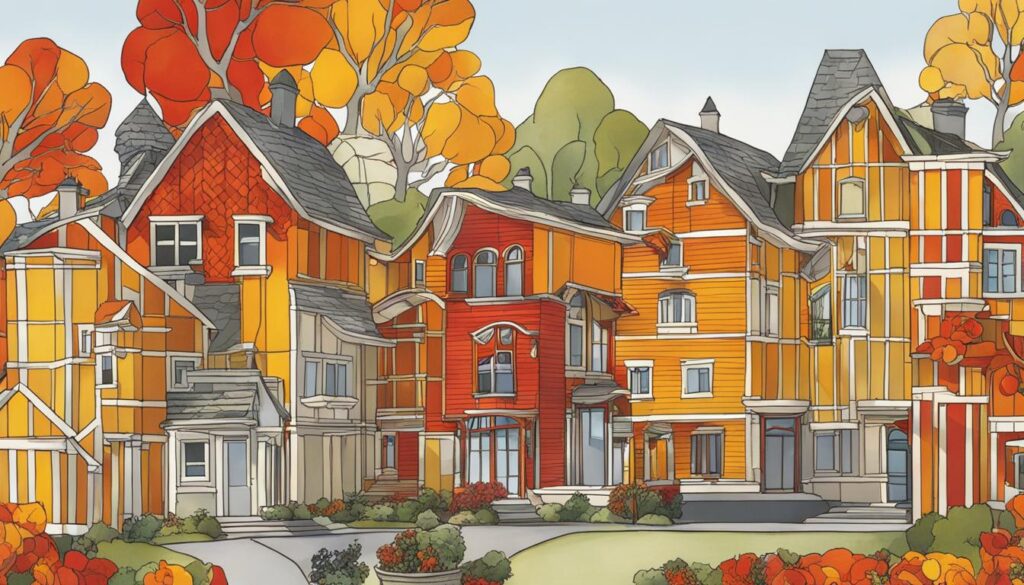If you’re a fan of Maeve Binchy’s writing, you’ll know that her novels are intricately woven tales that explore the lives of vibrant characters living in Dublin. “Quentins” is no exception. It’s a novel that takes us on a journey through the ups and downs of life, with love, loss, and friendship as recurring themes.
Set in the eponymous restaurant, “Quentins” portrays the lives of its diverse characters in a way that is both heartwarming and heartrending. From the staff to the patrons, each one has their own story to tell, and Binchy expertly weaves these tales together to create a tapestry of emotions that lingers long after the final page is turned.
Key Takeaways
- Binchy’s “Quentins” explores the themes of love, loss, and friendship through the lives of a diverse cast of characters set in Dublin.
- The novel takes place in the Quentins restaurant, which serves as a backdrop for the various narratives that intersect throughout the story.
- Binchy’s writing captures the essence of Dublin life and the power of community, resonating with readers globally.
- “Quentins” is a captivating read that leaves a lasting impression on its readers and continues to receive critical acclaim even after its publication.
About the Author, Maeve Binchy
Maeve Binchy, born in Dublin in 1940, was an acclaimed Irish novelist and journalist. She studied at University College Dublin and began her career as a teacher before transitioning to journalism. Binchy worked for The Irish Times and later became the women’s editor at The Irish Independent.
Binchy’s novels, including “Circle of Friends” and “Tara Road,” have sold millions of copies worldwide and have been translated into numerous languages. Her writing style is known for its warm, compassionate portrayal of human relationships and keen observation of everyday life.
“One of the things that I discovered when I started to write fiction was how you could take the observation that you made as a journalist and you could do something else with it,”
Introduction to “Quentins”
Transport yourself to the bustling streets of Dublin with Maeve Binchy’s “Quentins,” a tale of interconnected lives that takes the reader on a journey through the city’s diverse neighborhoods. At the heart of the story is the beloved restaurant, Quentins, which acts as a microcosm of Dublin life, bringing together people from all walks of life under one roof. Through the eyes of the restaurant’s staff and patrons, we experience the joys and struggles of love, loss, and friendship.
“Quentins was more than just a restaurant, of course, it was a member of the community, and so the community was going to help if there was trouble. Or that’s what everyone told Ella Brady afterward.”
– Maeve Binchy
The novel is a masterful exploration of the human experience, revealing the inner lives of its richly drawn characters with depth, nuance, and compassion. Binchy’s writing style is engaging and poignant, capturing the complexities of relationships and the emotional landscapes of her characters with precision and grace. “Quentins” is a must-read for anyone who loves stories that touch the heart and leave a lasting impression.
The Characters of “Quentins”
One of the greatest strengths of “Quentins” is its cast of diverse and captivating characters. From the staff of the eponymous restaurant to the patrons who frequent it, each individual brings their own unique story to the table, adding depth and complexity to the narrative.
At the helm of the novel is Ella Brady, an ambitious television producer who returns to Dublin to work on a documentary about Quentins. Along the way, she reconnects with childhood friend and Quentins co-owner, Don Richardson, and sparks begin to fly.
The restaurant staff is a colorful mix of personalities, from the fiery chef, Ria, to the charming bartender, Finbar. They provide the backbone of the Quentins community and their stories intersect with those of the patrons who visit the restaurant.
Notable patrons include the wealthy movie producer, Patrick O’Neill, who becomes enamored with his leading lady, the enigmatic and troubled actress, Brenda Fogarty. There is also Monaghan sisters, Sally and Grainne, whose longstanding sibling rivalry takes a surprising turn.
As Maeve Binchy weaves these individual threads into a tapestry of interconnected stories, she creates a rich and immersive world that readers won’t want to leave behind.
The Themes of Love and Relationships
Love and relationships are at the heart of Quentins, with the novel exploring various types of this complex emotion. Maeve Binchy masterfully portrays the different forms of love, from the passionate romance between Ella Brady and Don Richardson to the enduring love between mother and daughter shared by Brenda and Jennifer. The importance of familial bonds is also emphasized, as relationships between siblings and parents are explored with depth and authenticity.
Moreover, Binchy highlights the connections forged within the Quentins community, emphasizing the power of platonic relationships. The restaurant serves as a gathering place for charactersto share stories, and their struggles and triumphs. Through Quentins, the novel reminds readers of the importance of building and maintaining communities that allow us to support and go through life’s ups and downs together.

Love and Friendship: Two Sides of the Same Coin
“But if you don’t have love and support and the company of friends and family, then even when you have money, you’re worthless,” says Nora, one of the characters in the book. As Binchy explores the themes of love and friendship, we realize that the two notions are intricately linked. Friendship proves to be a significant source of love for many characters.
| Character | Type of Relationship | Impact of Relationship |
|---|---|---|
| Ella Brady | Don Richardson | Provides a sense of belonging and emotional fulfillment |
| Brenda Casey | Jennifer | Enduring, motherly love that offers solace during difficult times |
| Monica Brady | Alison | Solidarity and emotional support between friends who have lost their romantic partners |
“Never take a loving relationship for granted. You should always maintain it, nurture it, and continue to communicate with those whom you love.”
Through these relationships, Binchy explores the beauty and complexity of love in its various forms. Whether it’s the heart-wrenching pain of losing a loved one or the joy that comes from being surrounded by friends and family, love is a powerful force that impacts us all.
Dublin as a Character
In “Quentins,” Dublin is not merely a setting but a character in its own right, contributing to the novel’s rich and immersive reading experience. The city’s history, culture, and atmosphere are all intricately woven into the narrative, creating a sense of place that is palpable throughout the story. From the bustling streets to the iconic landmarks, Maeve Binchy’s vivid descriptions bring Dublin to life.
The Quentins restaurant serves as a microcosm of the city, with its diverse patrons and staff representing different facets of Dublin society. The restaurant’s ups and downs reflect the city’s own struggles and triumphs, making it a fitting backdrop for the novel’s interconnected stories of love, loss, and friendship.
The city’s history also plays a significant role in “Quentins,” with nods to Dublin’s past scattered throughout the novel. The story of the restaurant’s namesake, Quentin Barry, is a particularly poignant example of how the city’s past can impact its present and future.
In Dublin’s fair city, where the girls are so pretty… Oh, Molly Malone, alive, alive-o! – Maeve Binchy, Quentins
Binchy’s love for Dublin is evident in every page of “Quentins,” and the city’s enduring character is as much a part of the story as the human characters themselves.
Dublin’s Landmarks in “Quentins”
| Landmark | Description |
|---|---|
| St. Stephen’s Green | The park where Dolly and James fall in love. |
| O’Connell Street | The location of the fictional newspaper office where Brenda works. |
| The Abbey Theatre | Provides the setting for a pivotal scene involving Ria. |
| The Spire | Marks the location of a key moment in Fiona’s story. |
From St. Stephen’s Green to the Abbey Theatre, many of Dublin’s famous landmarks feature in “Quentins.” These nods to the city’s rich cultural heritage add an extra layer of depth to the novel, making it a must-read for anyone interested in the history and culture of Ireland’s capital.
The Power of Friendship
In “Quentins,” friendship is a vital component of the novel’s overarching theme. Through the unconditional bonds forged between the characters, readers gain insight into the transformative nature of this powerful force.
Friendship proves to be a source of solace for many of the characters, including Ella Brady, the protagonist of the novel. Traversing challenging situations in her personal and professional life, Ella finds comfort in her friendships, as she confides in her closest companions and gains valuable insights into her own character.
Moreover, friendship provides emotional support to the characters during moments of grief and loss. When Nan Mahon faces the death of her husband, she draws on the strength of her friends to help her navigate the turbulent waters of bereavement.
“It was a simple gesture, but it helped her in those early days when the nights were long and the house was silent. It was just the knowledge that there were people out there who cared for her and were thinking of her.”
The impact of friendship on character resilience is a key theme in the novel, underscoring the transformative potential of these bonds. Through shared experiences and a deep sense of support, the characters embody how friendship has the power to transform lives.
Exploring Loss and Resilience
“Quentins” explores the universal experiences of loss and resilience. Throughout the novel, characters grapple with personal tragedy and emotional setbacks, highlighting the fragility of life and the complex nature of human emotions.
Loss manifests in various forms, from the death of a loved one to the failure of a long-held dream. The characters of “Quentins” navigate the overwhelming grief that comes with such losses and must find a way to move forward despite their pain.
However, the novel also showcases the power of resilience, the ability to adapt and overcome adversity. In the face of personal tragedy, characters learn to draw strength from their connections with others, relying on friendship and community to persevere through difficult times.
Through its poignant depiction of loss and resilience, “Quentins” provides a moving portrayal of the human experience, reminding readers of the importance of cherishing life’s precious moments.
The Quentins Restaurant: A Symbol of Community
In “Quentins,” the eponymous restaurant is more than just a place to eat; it is a hub of activity that brings together a diverse group of individuals. From Maeve Binchy’s vivid descriptions of the bustling dining room to the mouth-watering descriptions of the menu items, the Quentins restaurant is a central fixture that unites the characters.
Through their interactions with the restaurant staff and fellow patrons, readers gain a glimpse into the vibrant community that Quentins has fostered. From young couples on first dates to elderly friends enjoying their weekly lunch, this establishment serves as a common ground for people from all walks of life.
Furthermore, the Quentins community is not limited to those who frequent the restaurant. The staff members of Quentins have formed their own tight-knit family, supporting one another through difficult times and celebrating together during moments of triumph.
Overall, the Quentins restaurant symbolizes the power of community and the importance of forging connections with those around us. It serves as a reminder that even in the hustle and bustle of city life, meaningful relationships and bonds can be fostered.
Plot Summary: A Tale of Interconnected Lives
Set in Dublin, “Quentins” follows the lives of a diverse cast of characters whose stories intertwine with one another. The novel primarily centers on the beloved restaurant, Quentins, its staff, and patrons.
The story begins as Ella Brady, a producer of a documentary about the restaurant, seeks out people whose lives have been touched by Quentins. As she interviews various individuals, their personal dramas and relationships come to light, revealing the inner workings of the restaurant and the city of Dublin itself.
Patrons like Monaghan brothers, Patrick and Brendan, who steal food from the restaurant become endeared to readers. They make you laugh and warm your heart, while readers will also be intrigued by the dynamics of Patrick’s unconventional family.
| Character | Description |
|---|---|
| Ella Brady | The producer of a documentary about Quentins |
| Patrick Monaghan | A quirky but loveable patron of the restaurant with an unconventional family |
| Brendan Monaghan | Patrick’s brother, who initially steals food from Quentins |
Meanwhile, the staff of the restaurant struggle with their own personal challenges. The head chef, Ria, grapples with a failing marriage and the infidelity of her husband. Her sous chef, Colm, finds himself caught in a love triangle with Ria and a young waitress named Connie.
Throughout the course of the novel, the lives of these interconnected characters collide, bringing joy, heartbreak, and unexpected twists and turns. Binchy’s expertly crafted plotlines make for an engaging and satisfying read.
Notable Quotes from “Quentins”
Quentins by Maeve Binchy is filled with memorable quotes that capture the heart of the novel. From poignant reflections on love and loss to witty observations about everyday life, Binchy weaves together a tapestry of language that resonates with readers long after the final page is turned. Here are some of the most notable quotes from Quentins:
“It was a crazy idea altogether, but there was something romantic about it, something that appealed to the flippant, crazy side of her.”
– Ella Brady
“Another day, another chance to be brilliant. Or fall flat on your face.”
– Patrick Godfrey
“Life isn’t all beer and skittles, you know. Sometimes it’s cider and darts.”
– Brenda Brennan
These and other insightful quotations make Quentins a must-read for lovers of great literature. Binchy’s masterful prose captures the essence of life in Dublin, offering readers a glimpse into the heart and soul of this vibrant city.
Critical Acclaim and Reader Reception
“Quentins” has garnered significant critical acclaim and captured the hearts of readers worldwide. Maeve Binchy’s masterful storytelling and dynamic characters have earned recognition and praise from literary critics and book lovers alike.
The novel was described by The New York Times Book Review as “a delightfully rich tapestry of life in Dublin,” emphasis on “rich tapestry”. The Times lauded Binchy’s ability to weave together the lives of so many characters within the restaurant’s walls, while People Magazine praised her for creating a “sense of time and place that turns the eating place into a character itself.”
Readers’ feedback on “Quentins” has been overwhelmingly positive, rating the novel 4.2 out of 5 on Goodreads. It has become a favorite among Binchy’s fans, who praise her ability to portray the complexity of human relationships. One reviewer wrote, “Binchy tells stories of everyday people in the most extraordinary and beautiful way.”
Themes that Resonate: Reflecting on “Quentins”
The themes explored throughout “Quentins” have resonated deeply with readers, offering a poignant reflection on the intricacies of life and the human experience. The enduring themes of love, loss, friendship, and community have struck a chord with many, showcasing the power of Binchy’s storytelling prowess and her ability to connect with her audience.
One of the most resonating themes is love, which is depicted in all its complexities, from the romantic spark between Ella and Don to the familial bonds that tie some of the characters together. As the characters navigate the highs and lows of their relationships, readers are reminded of the importance of human connection and the ways in which love can both uplift and devastate.
Loss and resilience are also themes that reverberate throughout the novel. From the devastating loss of Quentins to Benny’s battle with cancer, the characters must navigate grief and find ways to move forward amidst the challenges they face. Through their journeys, readers are reminded of the power of perseverance and the human spirit’s remarkable ability to overcome adversity.
Friendship is another vital theme in “Quentins,” highlighting the power of human connection and the solace and support it can provide. The relationships forged within the Quentins community showcase the value of supportive and unconditional friendships, offering readers a glimpse into the ways in which connections can provide comfort and strength during difficult times.

Finally, the theme of community underlines the importance of the places and people that shape our lives. Quentins restaurant represents a physical embodiment of community, showcasing the ways in which diverse individuals can come together around a shared goal or experience. Through their interactions, the characters demonstrate the power of communal ties, creating a tapestry of human connection that resonates long after the final page is turned.
Conclusion
In conclusion, Maeve Binchy’s “Quentins” offers a captivating exploration of Dublin life, love, loss, and the power of friendship. Through its dynamic characters and intricately woven plotlines, Binchy creates a tapestry of emotions that lingers with readers long after the final page is turned. The novel’s themes of love, friendship, and community have resonated with readers worldwide, cementing its place as a beloved work of contemporary fiction. Whether you’re a fan of Binchy or new to her writing, “Quentins” is a must-read for anyone looking for a heartfelt and engaging story.



